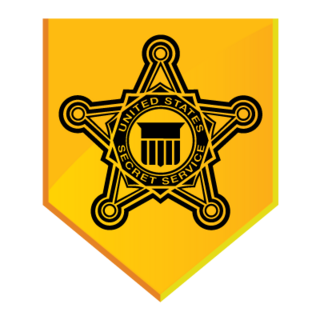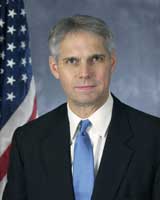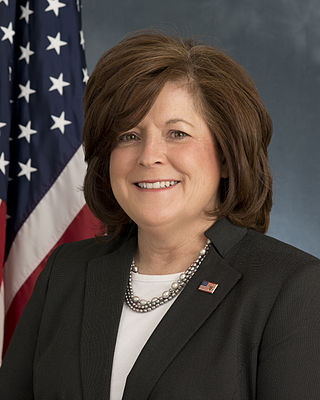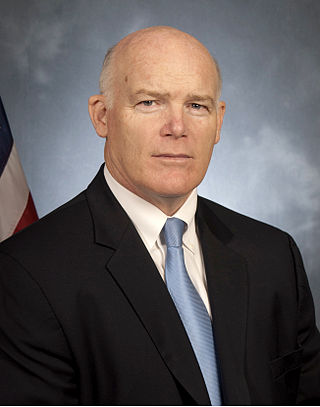
The United States Secret Service is a federal law enforcement agency under the Department of Homeland Security charged with conducting criminal investigations and protecting U.S. political leaders, their families, and visiting heads of state or government. Until 2003, the Secret Service was part of the Department of the Treasury, as the agency was founded in 1865 to combat the then-widespread counterfeiting of U.S. currency. President Abraham Lincoln signed the legislation on April 14, 1865, just a few hours before he was assassinated. In 1901, the Secret Service was also assigned to presidential protection duties.

James Scott Brady was an American public official who served as assistant to the U.S. president and the 17th White House Press Secretary, serving under President Ronald Reagan. In 1981, Brady became permanently disabled from a gunshot wound during the attempted assassination of Ronald Reagan by John Hinckley Jr., just two months and 10 days after Reagan's inauguration.

On November 22, 1963, John F. Kennedy, the 35th president of the United States, was assassinated while riding in a presidential motorcade through Dealey Plaza in Dallas, Texas. Kennedy was in the vehicle with his wife, Jacqueline, Texas Governor John Connally, and Connally's wife, Nellie, when he was fatally shot from the nearby Texas School Book Depository by former U.S. Marine Lee Harvey Oswald. The motorcade rushed to Parkland Memorial Hospital, where Kennedy was pronounced dead about 30 minutes after the shooting; Connally was also wounded in the attack but recovered. Vice President Lyndon B. Johnson was sworn in as president later that day.

On March 30, 1981, President of the United States Ronald Reagan was shot and wounded by John Hinckley Jr. in Washington, D.C., as he was returning to his limousine after a speaking engagement at the Washington Hilton. Hinckley believed the attack would impress actress Jodie Foster, with whom he had developed an erotomanic obsession.

Ronald Borek Kessler is an American journalist and author of 21 non-fiction books about the White House, U.S. Secret Service, FBI, and CIA.
On February 11, 2006, then-United States vice president Dick Cheney shot Harry Whittington, a then-78-year-old Texas attorney, with a 28-gauge Perazzi shotgun while participating in a quail hunt on a ranch in Riviera, Texas. Both Cheney and Whittington called the incident an accident.

Mark J. Sullivan is a former federal law enforcement agent who served as the 22nd Director of the United States Secret Service from May 31, 2006, to March 27, 2013. Sullivan succeeded W. Ralph Basham and was succeeded by Julia Pierson.

An assassination attempt on U.S. President Harry S. Truman occurred on November 1, 1950. It was carried out by militant Puerto Rican pro-independence activists Oscar Collazo and Griselio Torresola while President Harry S. Truman resided at Blair House during the renovation of the White House. Both men were stopped before gaining entry to the house. Torresola mortally wounded White House Police officer Leslie Coffelt, who killed him in return fire. Secret Service agents wounded Collazo. Truman was upstairs in the house and not harmed.

Carol Duhurst Leonnig is an American investigative journalist. She has been a staff writer at The Washington Post since 2000, and was part of a team of national security reporters that won the 2014 Pulitzer Prize for Public Service for reporting, which revealed the NSA's expanded spying on Americans. Leonnig also received Pulitzer Prizes for National Reporting in 2015 and 2018.

Jerry S. Parr was a United States Secret Service special agent who is best known for defending President Ronald Reagan during the attempt on the president's life on March 30, 1981, in Washington, D.C. Parr pushed Reagan into the presidential limousine and made the critical decision to divert the presidential motorcade to George Washington University Hospital instead of returning to the White House. He was honored for his actions that day with U.S. Congress commendations, and is widely credited with helping to save the president's life.

Alan Kay is a United States magistrate judge for the United States District Court for the District of Columbia.

Barack Obama, the 44th president of the United States, was involved in multiple security incidents, including several assassination threats and plots, starting from when he became a presidential candidate in 2007. Secret Service protection for Obama began after he received a death threat in 2007, while serving as the junior United States senator from Illinois and running for president. This marked the earliest time a candidate received such protection before being nominated. Security was increased early for Obama due to fears of possible assassination attempts by white supremacist or other racist groups or individuals against the first African American major party presidential nominee.

The sixth Summit of the Americas was held at Cartagena, Colombia, on April 14–15, 2012. The central theme of the summit was "Connecting the Americas: Partners for Prosperity." The main issues at the summit's agenda was the exclusion of Cuba, the legalisation of drugs to fight the War on Drugs and Argentina's sovereignty claims over the Falkland Islands. Additionally, criticism of an expansionist monetary policy was also leveled on the developed economies. A final statement was not forthcoming over the issue of Cuba's inclusion in the next summit which was supported by all states except the United States and Canada. Panama was chosen to host the 7th Summit of the Americas.

Julia Ann Pierson is an American former law enforcement official. She served as the 23rd Director of the United States Secret Service. Pierson became director on March 27, 2013. Amid a series of security lapses involving the agency, Pierson resigned on October 1, 2014.

The 2014 White House intrusion occurred on September 19, 2014, when Omar J. Gonzalez, an Iraq War veteran with post-traumatic stress disorder, jumped over the White House's fence and entered the building's front door, overpowered a security officer, was stopped by another who was off-duty, then later by multiple security officers, and arrested. He was found to have a small knife in his pocket, and stated that the "atmosphere was collapsing" and he needed to tell the president so that he could alert the public. President Barack Obama and his family were not home at the time of the incident. As a result of this incident and other security breaches at the White House, the then-director of the United States Secret Service, Julia Pierson, resigned from her position on October 1, 2014.

Joseph "Joe" P. Clancy is an American law enforcement official. He was the 24th Director of the United States Secret Service. Clancy previously served as head of the agency's presidential protection division until 2011, when he retired and became director of corporate security for Comcast.
The 2016 White House shooting occurred on May 20, 2016, when Jesse Olivieri attacked the White House security checkpoint. The Secret Service shot and arrested him. After the incident, Secret Service authorities closed the White House for 45 minutes and also blocked nearby streets. Primary investigations showed that there is no connection with terrorists.

Anthony M. Ornato is the former assistant director of the United States Secret Service Office of Training. He was the service's deputy assistant director who headed the security detail of president Donald Trump until taking a leave of absence when the president named him White House Deputy Chief of Staff for operations in December 2019. After his tenure as a political appointee in the Trump administration, he returned to the Secret Service where he worked as the assistant director in the office of training until August 29, 2022.




















